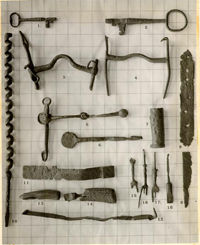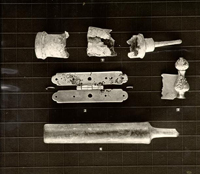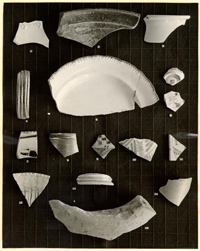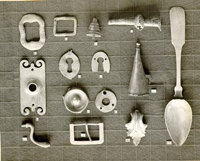Governor's Palace Stable Archaeological Report, Block 20 Building 4Originally entitled: "The Site of the Palace Stables Archaeological Evidence"
Colonial Williamsburg Foundation Library Research Report Series - 1471
Colonial Williamsburg Foundation Library
Williamsburg, Virginia
1990
THE SITE OF THE PALACE STABLES Archaeological Evidence
ILLUSTRATIONS.
| PLATE I. | Objects of iron. |
| PLATE II. | Items of brass. |
| PLATE III. | Items of brass, glass and pewter. |
| PLATE IV. | Representative ceramic sherds. |
Scale: Each square represents one inch.
The Palace Stables — Archaeological Evidence
The excavation of the Palace site was carried out in 1930 under the direction of Mr. Prentis Duell and subsequently by Mr. Herbert S. Ragland. However, only the former's notes are included in the architectural report. Unhappily, they represent merely an impression of the nature of the work and give no details regarding artifacts recovered or of archaeological dating for the individual structures and strata. The only reference to the stables reads as follows:
"The foundations of the Stable to the north of the Cemetery are partially uncovered; the building appears to have been large and substantially built, the principle wall being five feet in thickness."This identification of the stable site is no longer considered valid. The recent discovery of a note by one Thomas Pickering, 1745-1829, clearly places the stable closer to the Palace. The note reads as follows:
"In a building near the palace are to be seen the remains of the richly ornamented state coach, which was brought over with Lord Botetourt, and once used by him to carry him from the palace to the Capitol…"Further information is derived from two insurance policies of 1837 and 1838, both of which show a stable building on a north-south axis in the southeast corner of the site. In the first the building is described as being of brick covered with wood and measuring 36 x 32 feet, while the second gives the measurements as 34 x 40 feet. Archaeological evidence recovered from the well (20A28) indicates that stabling was to be found in the vicinity in the mid 19th century.
The archaeological plan of the site (1930-32, revised 1933) shows traces of foundations running east-west in the southeast corner of the area 20A27. Insufficient sections of walling were found to show whether they represented one long structure (as well they might) or more than one. It should be noted
 PLATE I. OBJECTS OF IRON.
2
that measurements given in the 19th century insurance policies do not fit those provided by the surviving foundations. The lack of structural evidence in this corner of the site has been explained by Mr. Moorehead as the result of drastic grading in the area west of North England Street.
PLATE I. OBJECTS OF IRON.
2
that measurements given in the 19th century insurance policies do not fit those provided by the surviving foundations. The lack of structural evidence in this corner of the site has been explained by Mr. Moorehead as the result of drastic grading in the area west of North England Street.
On the assumption that the stables were situated in the southeast corner of the area designated as 20A27, the archaeological laboratory was requested to consider the artifactual evidence in the hope that it would throw light on the fittings, fixtures, and paraphernalia of the colonial stables. The following notes attempt to promote this end.
It is first necessary to draw attention to the fact that area 20A27 is the largest in the vicinity of the Palace and that it includes a number of features, notably the eastern advance building, various small foundations around it, the southeast entrance and foundations backing onto it, the long rectangular foundation in the southeast corner, as well as the entire garden area east of the ballroom. The numbering of the stored artifacts makes no distinction between any of these features, thus making it impossible to identify items with any one of them. The only division made within the area 20A27 is that of the well east of the advance building which is marked as 20A28. However, this covers not only the contents of the well, but also the square of ground in its immediate vicinity. Nevertheless, the nature and state of preservation of the retained artifacts suggests that most, if not all of them were covered from the filling of the well. Unfortunately this material fails to advance our knowledge of the area, for the well contents would appear to have dated from the mid 19th century.
Excluding the well contents - which, in fact, contained a number of items associated with stabling - it cannot be claimed that the area 20A27 yielded more such items than did other parts of the Palace site.
The items illustrated and noted here are representative of the material recovered, but for brevity's sake a number of unidentified, very fragmentary or common items have been omitted. Attention is drawn to the fact that some pieces 3 of builders' hardware are not mentioned on the grounds that they were in no way distinctive and do not suggest that any one of the buildings possessed hinges, locks, etc., which were at variance with the normal run of such items used elsewhere in Williamsburg.
Horse Furniture
20A27
This area yielded three iron bits (Pl. I, nos. 3-5) all of which may be of colonial date, one brass harness buckle (Pl. II, no. 12) of the same period, part of a stirrup and a horseshoe probably 19th century, as well as a small fragment of a brass spur; this last item is probably of the 18th century. Of particular interest are the remains of a large pewter syringe (Pl. III, no. 1) which may well have been used for veterinary purposes. Dating is uncertain, but it probably belongs to the late 18th or early 19th century. However, it is not thought to be of the colonial period.
20A28
Finds from the well included two stirrups, both of which might date from the 18th century and are currently displayed as such in the Court House of 1770. However, the dating of the well contents must indicate that they were in use in the 19th century, so eliminating them as evidence. Other finds included a horseshoe whose toecap indicated its 19th century date, and a large hub sleeve from a farm cart. These pieces are almost impossible to date; but similar forms are known to have been in use in the second half of the 18th century.
Miscellaneous Ironwork
20A27
Numerous iron objects were recovered from the area and a selection is shown in Pl. I. They have been identified as follows:
4(1 & 2) keys, 18th century. (3 - 5) harness bits. (6) unidentified. (7) bayonet socket, revolutionary. (8) tip of sword blade? (9) part of ornamental "H" hinge, colonial. (10) auger, probably 18th century. This is one of three, the last of which is almost certainly of recent date. (11) lock bolt, possibly 18th century. (12) object of uncertain use, probably 18th century. (13 & 14) horn knife handles, late 18th or 19th century. (15 - 17) forks, 18th century. (18) knife shank and tang, a form which could date as early as the 17th century.
20A20
The late date of the well filling makes it unnecessary to describe the iron items found in it.
Objects of Brass or Copper
A representative selection of these items are illustrated in Pls. II & III, but it will be observed that they have little obvious bearing on stables and stable equipment. They do, however, suggest that cabinet repairs may have been carried on in the vicinity. The items are as follows:
20A27. Pl. II
(1 & 2) shoe buckles, colonial. (3) finial of uncertain purpose. (4) finial or ferrule of uncertain date. (5 & 6) key-hole escutcheons. (7) door-handle escutcheon or perhaps terret base, 18th century. (10) candle snuffer, 18th or 19th century. (11) part of drop handle, 18th century. (12) harness buckle. (13) ornamental fitting from furniture corner, Empire. (14) spoon, early 19th century, described as from "E of Palace."
20A27. Pl. III.
(2) hinge of "H" type, similar in shape to the iron example illustrated by Pl. I, no. 9. This is considered to have been a cabinet piece, for it was held in place by only two screws at the centre and eight small brass pins, a combination which could not have carried much weight. The hinge pin is of iron — 18th century.
 PLATE III. ITEMS OF BRASS, GLASS & PEWTER.
5
(3) ornamental brass hinge, retaining traces of iron pin and originally held to the door by two screws. Colonial.
PLATE III. ITEMS OF BRASS, GLASS & PEWTER.
5
(3) ornamental brass hinge, retaining traces of iron pin and originally held to the door by two screws. Colonial.
20A28
Brass items from the well area include four buttons, two of which may date from the last years of the 18th century, and a well preserved epaulette which is understood to date from the Civil War era. These items are not illustrated.
Ceramics
The ceramic items from 20A27 do not help in locating the Palace stables, nor are they sufficiently well labelled for them to be of any archaeological value. Consequently, only a representative selection has been chosen for illustration. It should be noted, however, that a considerable proportion of the ceramic finds stemmed from the post colonial period. These are not illustrated.
20A27. Pl. IV
(1) creamware plate rim. (2) coarse, lead-glazed cream-pan rim. (3) rim fragment of salt-glazed chamber-pot. (4) handle of Fulham style brown stoneware tankard. (5) Fragments of blue-edged, white earthenware plate, late 18th century. (6) basal fragments of Chinese porcelain. (7) rim fragment of Staffordshire, moulded slipware dish, first third of 18th century. (8) rim of brown stoneware jug. (9) body fragment of Westerwald jug. (10) body fragment of English delft drug jar. (11) edge fragment of delft tile. (12) rim sherd of Staffordshire combed slipware dish. (13) basal fragment of English delft drug jar. (14) rim sherd of Fulham style tankard. (15) rim fragment of large, red-bodied storage jar with thin internal lead glazing. This is similar to the jars recovered from revolutionary wrecks at Yorktown and is considered to have been of Spanish origin.
Dating for the above items is given only where the illustration are not self-explanatory.
 PLATE IV. REPRESENTATIVE CERAMIC SHERDS.
PLATE IV. REPRESENTATIVE CERAMIC SHERDS.
It is worth noting that the coarse wares from this area were more plentiful than any other single group and might suggest the presence of a kitchen or buttery. It is improbable that broken kitchen wares from the kitchen west of the Palace would have been disposed of to the east of it. It may, therefore, be suggested that slaves, grooms or some such persons may have had their own cooking facilities in the area 20A27.
Notable among the coarse fragments were examples of wares from Barnstaple in Devonshire and Buckley in North Wales, both types which are readily datable within the colonial period.
Glass
As on every other site in town, beverage bottle fragments are plentiful and range from the early 18th century onwards. A few pharmaceutical phial pieces were also among the finds, but not in sufficient numbers to be significant. Of some interest is the tall phial illustrated in Pl. III, no. 4. This is of clear glass (unusual for the type) and dates from the latter part of the 18th century. Such vessels have been described both as containers for salt (Country Life. Feb. 1955) and for eau de Cologne (Country Life. March, 1955). The presence of no fewer than eight 18th century tumbler bases may or may not be significant. They are not of good quality and could well have been used among servants.
CONCLUSIONS
The foregoing summary of the finds from area 20A27 suggests the presence of a kitchen or some building in which food was prepared. It may also be deduced that furniture was repaired in the vicinity in the latter part of the 18th century. There is, however, no archaeological evidence for a stable there in the 18th century. The presence of what appear to be 18th century harness items in the well's 19th century filling only suggests that Samuel F. Bright, owner of the land in the 2nd quarter of the 19th century, possessed equipment which was not new. If this 7 assumption is accepted, it could also be extended to include the three harness bits recovered from the area 20A27, thus destroying all archaeological evidence supporting the existence of an 18th century stable to the east of the Palace. Such reasoning is in no way conclusive, for the absence of evidence in archaeology can rarely be used as proof either for or against a theory.
In short a verdict regarding the site of the Palace stable must, on the archaeological evidence alone, be brought in as one of "not proven."
I. N. H.
13th December. 1957
